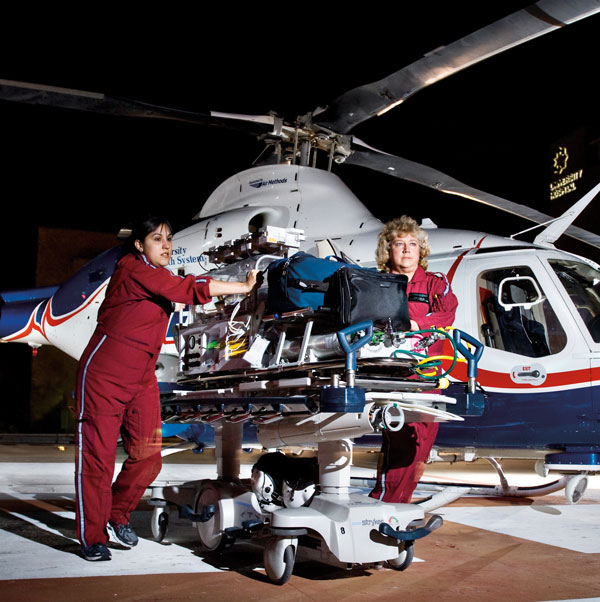
When the phone rings in pediatric and neonatal transport units of San Antonio area hospitals, chances are good that a UT Health Science Center respiratory care alumnus will be called upon to help save a life.
Respiratory therapists work as part of a hospital’s medical team, providing care during transport for critically ill or injured children from throughout South Texas. Therapists travel to the patient by ambulance, helicopter, propeller plane or jet to provide assistance with respiratory issues.

Lori Craft, B.S.R.C., RRT, a graduate of the inaugural UT Health Science Center respiratory care program in 1996, is a senior member of the pediatric transport team at CHRISTUS Santa Rosa Children’s Hospital. Alumni Mayra Fernandez, B.S.R.C., RRT, a 2006 graduate, and Chris Tolentino, B.S.R.C., RRT, who graduated in 2009, also work there.
Craft recalled a recent incident when she was called on to fly to El Paso in a twin-engine airplane retrofitted with medical equipment. She only knew that she would be providing care for a very sick child on a ventilator.
An hour later at the border city hospital, Craft examined the 3-year-old’s X-rays. The School of Health Professions graduate knew this was a very serious case. The little girl had necrotizing pneumonia, flesh-eating bacteria in the lungs.
Her job – along with her teammates – a critical care nurse and physician – was to stabilize the patient by providing intensive-care during transport until the child could receive care at the hospital.
“We provide care for children who are just a few days old to age 18 with any type of medical problem. They could have complex medical issues, critical care issues, trauma or congenital heart issues,” she said.
Another alumna, Melissa Treviño-Alvarez, M.S., RRT-NPS, (class of 2001) is a member of the University Health System transport team that includes graduates Mandy Livingston, B.S.R.C., RRT, (class of 2000) and Andy Rodriguez, RRT, a 2007 graduate. At Methodist Children’s Hospital, Ali Soujoudi, B.S.R.C., RRT, a 1999 graduate, serves on the pediatric transport team.
Treviño-Alvarez already had a degree in chemistry and was working as a pharmacy technician when she learned of the respiratory care program at the Health Science Center. “I became interested in respiratory care when I realized that my grandfather had died from an occupational illness called silicosis,” she said. The disease is caused by longtime exposure to silica dust and is sometimes called stonemason’s disease. “I wanted to know more about how to prevent such illnesses and how to treat the patients who suffer from them,” she said, “but as soon as I began my neonatal/pediatric class, I was hooked. I knew that I wanted to work in the Neonatal Intensive Care Unit after graduation.
“Neonatal respiratory therapists are responsible for all infants who are receiving any type of oxygen therapy, whether it is through a device as simple as a nasal cannula (an oxygen delivery system) or as complex as a ventilator,” said Treviño-Alvarez, who has worked at University Health System for 11 years. She was the lead respiratory therapist in the Neonatal Intensive Care Unit before becoming senior educator for the Department of Respiratory Care.

“We attend all high-risk deliveries, and most of our therapists are certified for transport. Our neonatal transport team at University Hospital is composed of a nurse, respiratory therapist and either a physician or neonatal nurse practitioner. We can be called to pick up babies as close as across town or as far away as McAllen,” she said.
Donna “De De” Gardner, M.S.H.P., chair and associate professor of respiratory care at the Health Science Center, noted that respiratory therapists are integral members of the medical team and work directly with the physician regarding the cardiopulmonary health care of patients. “They are experts at managing patients receiving mechanical ventilation in intensive care units,” she explained.
A unique neonatal and pediatric specialty area where respiratory therapists utilize their skills is with extra corporeal membrane oxygenation (ECMO), a machine that helps oxygenate the blood while giving the lungs a rest. In fact, Health Science Center alumna Casey Howard, B.S.R.C., RRT, a 2002 graduate, is the first respiratory therapist in San Antonio to become an ECMO coordinator, Gardner said. “He also was the first respiratory therapist in San Antonio to join the ECMO team at Santa Rosa. He received the 2010 Alumni Award for his leadership in the city and the excellent care he provides,” Gardner said.
Respiratory therapists also work with children who have been involved in motor vehicle accidents or other trauma involving lung injury, she said.
Speaking of the Health Science Center’s program, Gardner said, “The first-attempt exam pass rate for 2011 graduates on the entry level examination — the CRT (certified respiratory therapy exam) — was 100 percent, and the overall pass rates on the advanced practitioner examination — the RRT (Registered Respiratory Therapy examination) — was also 100 percent,” Gardner said. “Over the last 12 years, our graduates are employed before they graduate due to the quality of the program and credentials they obtain prior to graduation,” she said.
At the UT Health Science Center San Antonio, bachelor’s degree completion program is available to registered respiratory therapists with an associate’s degree from a regionally accredited program. “Affiliations are in place with St. Philip’s College, Howard College, South Texas College and Fort Sam Houston’s associate degree program for graduates who have earned their RRT credential. This means that students are able to earn their bachelor’s degree in respiratory therapy after they obtain an associate’s degree,” Gardner explained.
As part of the program, prior to graduation, respiratory care students can enter internships in settings throughout the U.S. Recent students have had internships in top medical centers in Texas and throughout the country including Massachusetts General Hospital in Boston, Texas Children’s Hospital in Dallas and Johns Hopkins University in Baltimore.
For Lori Craft, who completed the program 15 years ago and has become an expert in pediatric critical respiratory care, the profession offers an adrenalin rush that frequently has a happy ending. “I like critical care and pediatric critical care. It’s very challenging and it tests a lot of my abilities,” she said. “It keeps me on my toes. For anyone who is interested in a job that is never the same, day to day, this is the job for you.”
For more information about the Health Science Center’s respiratory care program, visit uthscsa.edu/shp/rc/.
